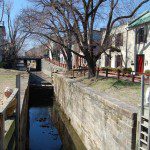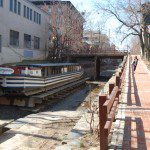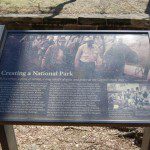60 Years Ago, Hike by Justice Douglas Saved the C&O Canal
By • April 21, 2014 0 5058

March 20 marks the 60th anniversary of Supreme Court Justice William O. Douglas’s historic walk of the entire 184.5-mile length of the towpath of the Chesapeake and Ohio Canal to help save it from becoming a parkway.
Do you know the story? The following was provided by the C&O Canal Trust:
In the 1950s, due to the explosion of America’s automobile culture and President Eisenhower’s push for an interstate system, highway construction was common throughout the country. Even the Washington Post, in a January 3, 1954 editorial, stated that the old canal was “no longer either a commercial or scenic asset” and that a highway, proposed by the National Park Service itself and approved by Congress, was a fine way to make the Potomac Valley accessible to sightseers, campers, and hikers. “The basic advantage of the parkway is that it would enable more people to enjoy beauties now seen by very few.”
Supreme Court Justice William O. Douglas had grown to love the C&O Canal, hiking 15 to 20 miles every Sunday to stay in shape. With his beloved canal in peril, Justice Douglas fired back a written response to the Washington Post:
“The stretch of 185 miles of country from Washington, D.C., to Cumberland, Md., is one of the most fascinating and picturesque in the Nation . . . It is a refuge, a place of retreat, a long stretch of quiet and peace . . . a wilderness area where we can commune with God and nature, a place not yet marred by the roar of wheels and the sound of horns.”
In addition, Douglas challenged Post editors Merlo Pusey and Robert Esterbrook to hike with him the entire distance, hoping to convince them to “. . . use the power of [the Post’s] editorial page to help.”
On March 20, 1954, Douglas, Pusey and Esterbrook started their hike of the entire 184.5 miles of the park from Cumberland, Md., to Georgetown.
Douglas’s adoption of the cause provided a focal point for media attention and intensified the efforts of conservation groups, such as the Wilderness Society and the National Parks Association that sought to preserve the canal. Many others, from preservationists to naturalists, from well-wishers to curiosity seekers, joined the hike, too, making it an unqualified success.
The Washington Post retracted its initial editorial, and the National Park Service abandoned the parkway idea in 1956. Nevertheless, Douglas and the conservationists did not immediately realize their dream. Only after numerous reunion hikes and years of sophisticated lobbying on Capitol Hill did the Chesapeake and Ohio Canal finally become a National Historical Park in 1971.
For his immense efforts in preserving and protecting its natural and historic resources, the C&O Canal is the only national park dedicated to the memory of one person: William O. Douglas.
Justice Douglas, visionary and activist, was truly instrumental in protecting this special place that is today the C&O Canal National Historical Park. It is up to us to keep his vision alive.
For more information, contact Mike Nardolilli, president of the C&O Canal Trust at 301-714-2233 or [www. CanalTrust.org](http://www.canaltrust.org/trust/)
- Bust of Supreme Court Justice William O. Douglas on the C&O Canal towpath at 30th Street in Georgetown. It was erected in 1977.
- Nora Birch






